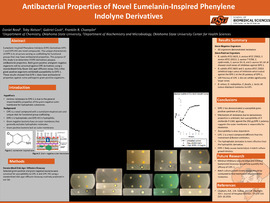| dc.contributor.author | Reed, Daniel | |
| dc.contributor.author | Nelson, Toby | |
| dc.contributor.author | Cook, Gabriel | |
| dc.contributor.author | Champlin, Franklin R. | |
| dc.date.accessioned | 2020-05-05T19:37:57Z | |
| dc.date.available | 2020-05-05T19:37:57Z | |
| dc.date.issued | 2020-02-28 | |
| dc.identifier | ouhd_reed_antibacterialpropertiesofnovel_2020 | |
| dc.identifier.citation | Reed, D., Nelson, T., Cook, G., & Champlin, F. R. (2020, Feb. 28). Antibacterial properties of novel Eumelanin-Inspired Phenylene Indolyne derivatives. Poster presented at Research Day at Oklahoma State University Center for Health Sciences, Tulsa, OK. | |
| dc.identifier.uri | https://hdl.handle.net/11244/324241 | |
| dc.description.abstract | BACKGROUND: The eumelanin core represents a novel compound having the intrinsic ability to act as scaffolding for functional groups which may possess antibacterial properties. The purpose of this study was to investigate the antibacterial potential of eumelanin-inspired phenylene indolyne (EIPE) derivatives EIPE-1 and EIPE-HCl which are hydrophobic and hydrophilic, respectively. | |
| dc.description.abstract | METHODS: A standardized disk agar diffusion bioassay was employed to determine the susceptibility and resistance levels of 12 gram-positive and 13 gram-negative bacteria to nonpolar and polar EIPE derivatives. The bioassay was performed by dissolving the compounds in dimethyl sulfoxide and impregnating filter paper disks which were placed onto Mueller Hinton agar plates spread inoculated in a standardized manner to obtain even cell lawns after incubation for 18±1 hours at 37°C. Zones of growth inhibition were measured with the aid of electronic calipers. | |
| dc.description.abstract | RESULTS: Five strains of Staphylococcus aureus, plus Bacillus subtilis and Staphylococcus epidermidis were all found to be susceptible to the hydrophobic derivative EIPE-1, while other gram-positive and all gram-negative organisms exhibited resistant phenotypes at potencies tested. The more polar EIPE-HCl derivative failed to inhibit growth of any of the organisms examined, regardless of gram reactivity. | |
| dc.description.abstract | CONCLUSION: Hydrophobic EIPE derivative EIPE-1 clearly possesses a gram-positive antibacterial spectrum, although only certain organisms are susceptible at the potencies employed for this study. The susceptibility of two methicillin-resistant S. aureus strains (SFL 8 and SFL 64) to EIPE-1 suggests that its mechanism of action does not involve the penicillin-binding proteins of peptidoglycan biosynthesis targeted by mainstream B-lactam antibiotics. The uniform resistance of 13 phylogenetically disparate gram-negative bacteria supports the notion that intrinsic outer membrane exclusion properties may play a role in the mechanism underlying their phenotypic resistance to the molecule. The more polar EIPE-HCl possesses no antibacterial properties at the potencies examined here. Future work will include performing minimal inhibitory concentration bioassays to quantitatively describe susceptibly in selected gram-positive bacteria. In addition, batch culture growth kinetics assays will be crucial to learning the cellular and molecular mechanisms responsible for susceptibility and resistance to EIPE-1. | |
| dc.format | application/pdf | |
| dc.language | en_US | |
| dc.publisher | Oklahoma State University Center for Health Services | |
| dc.rights | The author(s) retain the copyright of have the right to deposit the item giving the Oklahoma State University Library a limited, non-exclusive right to share this material in its institutional repository. Contact Digital Resources and Discovery Services at lib-dis@okstate.edu or 405-744-9161 for the permission policy on the use, reproduction or distribution of this material. | |
| dc.title | Antibacterial properties of novel Eumelanin-Inspired Phenylene Indolyne derivatives | |
| osu.filename | ouhd_reed_antibacterialpropertiesofnovel_2020.pdf | |
| dc.type.genre | Presentation | |
| dc.type.material | Text | |
| dc.subject.keywords | eumelanin derivatives | |
| dc.subject.keywords | antibacterial properties | |
| dc.subject.keywords | bacterial susceptibility | |
